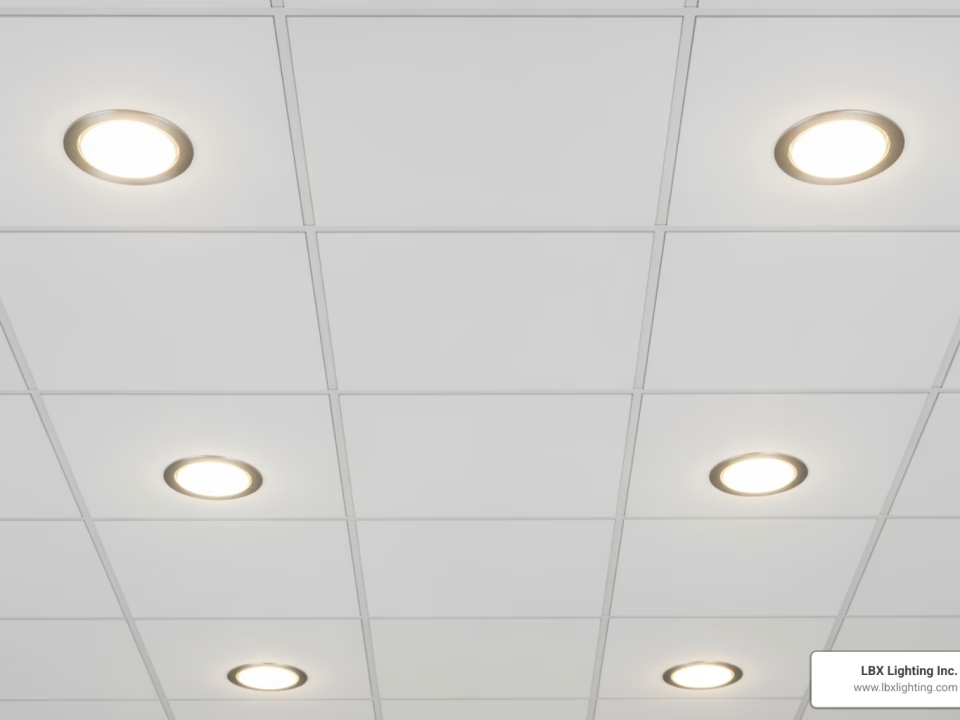
Illuminate Your Space: Houston’s Premier Commercial LED Lighting
April 2, 2025
Light Up Your Space: Decorative Track Lighting Options
April 5, 2025LED lighting control systems are revolutionizing the way we illuminate our spaces, offering a seamless fusion of efficiency and versatility. These systems represent the pinnacle of modern lighting technology, enhancing environments through intelligent management of light sources. LED lighting control systems offer:
- Improved energy efficiency by reducing wastage
- Personalized lighting experiences through smart controls
- Improved safety and aesthetics in both residential and commercial spaces
Today’s LED lighting and control systems are not just about illumination; they are about creating adaptable and energy-efficient environments that cater to individual needs and preferences. Imagine a lighting system that not only brightens your space but also adapts to your lifestyle—this is the promise of smart lighting through LED control systems.
With over 30 years of experience in lighting solutions, I, Michael Eftekhar, understand the transformative potential of LED lighting control systems. At LBX Lighting Inc., we are committed to providing you with the best lighting products and services to meet your needs in both commercial and residential settings. Let’s dig deeper into LED lighting control systems and explore the myriad benefits they bring.
Must-know LED lighting control systems terms:
– LED lighting for businesses
– LED lighting for parking lots
Types of LED Lighting Control Systems
When it comes to LED lighting control systems, there are several types that cater to different needs and preferences. Let’s break down these systems to understand how they can transform your lighting experience.
Manual Control
Manual control is the simplest form of lighting control. It involves using switches or dimmers to manually adjust the lighting. This method is straightforward but offers limited flexibility. It’s ideal for spaces where the lighting needs don’t frequently change.
Time-Based Control
Time-based control systems use timers to turn lights on and off at set intervals. This is especially useful for businesses that operate on a schedule. By automating lighting based on time, you can ensure lights are only on when needed, saving energy and reducing costs.
Occupancy Sensors
Occupancy sensors are a game-changer in lighting control. These sensors detect when a room is occupied and automatically adjust the lighting. They’re perfect for areas like conference rooms or restrooms, where lights should be off when no one is present. This reduces energy waste and improves convenience.
Photosensors
Photosensors adjust lighting based on natural light levels. As daylight increases, these sensors dim or turn off the lights to maintain a consistent light level. This is known as daylight harvesting and is ideal for spaces with plenty of windows.
Dimming Systems
Dimming systems allow users to adjust the brightness of lights to suit different activities or moods. This not only improves ambiance but also contributes to energy savings. Dimming lights by just 10% can lead to significant energy savings over time.
Color Temperature Control
Color temperature control lets you change the warmth or coolness of the light. This is useful in settings where the mood or functionality of the space changes throughout the day. For example, cool lighting can boost productivity in an office, while warm lighting can create a cozy atmosphere at home.
Networked Systems
Networked systems integrate lighting controls with other building management systems. This allows for centralized control over lighting, HVAC, and more. It’s a sophisticated option for large commercial buildings seeking efficiency and ease of management.
Wireless Systems
Wireless systems offer the ultimate flexibility in lighting control. They eliminate the need for complex wiring, making them easy to install and expand. Using technologies like Bluetooth Mesh, these systems allow control from smartphones or tablets, making them ideal for modern smart homes and offices.
Each type of LED lighting control system offers unique advantages, allowing you to tailor your lighting to your specific needs. Whether you’re looking for simplicity with manual controls or the advanced capabilities of networked systems, there’s a solution to fit every requirement.
Benefits of LED Lighting Control Systems
LED lighting control systems offer a range of benefits that can transform both residential and commercial spaces. Let’s explore some of the key advantages:
Energy Savings
One of the most significant benefits of using LED lighting control systems is the potential for energy savings. According to a meta-analysis by Lawrence Berkeley National Laboratory, integrating controls with LED lighting can reduce energy usage by 25-75% compared to non-controlled lights. This reduction not only lowers electricity bills but also contributes to a more sustainable environment.
Controllability
With LED lighting control systems, you gain precise control over your lighting environment. Whether it’s adjusting the brightness, changing the color temperature, or setting schedules, these systems offer best flexibility. For example, using dimming systems can help create the perfect ambiance for any occasion while also conserving energy.
Safety
Safety is another crucial benefit of LED lighting controls. In areas like stairways and parking structures, proper lighting is essential for preventing accidents. LED systems can be programmed to ensure these areas are well-lit at all times, enhancing safety for occupants. Additionally, features like motion detection can provide instant visibility, which is vital for security.
Maintenance Cost Reduction
LED lights are known for their longevity, often lasting up to 100,000 hours. When combined with smart control systems, maintenance costs can be further reduced. Automated systems can log burn hours and notify when maintenance is required, minimizing downtime and reducing labor costs associated with manual checks.
Incorporating LED lighting control systems into your space not only optimizes energy use but also improves safety, reduces maintenance costs, and provides superior control over your lighting environment. This makes them a smart investment for anyone looking to improve efficiency and comfort in their home or business.
Next, we’ll dive into how these systems work, exploring the technology behind phosphor blends, emission spectrums, and more.
How LED Lighting Control Systems Work
Understanding how LED lighting control systems work can help you make the most of their benefits. Let’s look at some of the key elements that make these systems effective.
Phosphor Blend
LEDs don’t just emit one color of light. They use a phosphor blend to create the white light we see in homes and offices. When blue or ultraviolet light from the LED hits the phosphor coating, it transforms into white light. This process allows for a wide range of colors and temperatures, making LEDs versatile for any setting.
Emission Spectrum
The emission spectrum of an LED is the range of light wavelengths it produces. Unlike traditional bulbs, LEDs can be fine-tuned to emit specific wavelengths. This precision is crucial for applications like healthcare, where certain light spectrums can improve patient comfort and care. IoT in healthcare shows how LEDs can integrate with IoT controls to improve efficiency without compromising patient experience.
Color Temperature
Color temperature refers to the warmth or coolness of the light emitted by an LED. Measured in Kelvin (K), lower temperatures (around 2700K) produce a warm, cozy light, while higher temperatures (up to 6500K) offer a cool, daylight-like effect. Adjusting the color temperature can impact mood and productivity, making it an essential feature for offices and homes. LBX Lighting emphasizes how different lighting tones can affect ambience and mood.
LED Package
The LED package includes the LED chip, phosphor, and other components that protect the LED and improve its performance. It ensures the LED can withstand various environmental conditions and maintain its efficiency over time. This package plays a crucial role in the longevity and durability of LED lighting systems, contributing to reduced maintenance costs.
By understanding these components, you can appreciate how LED lighting control systems work and how they can be custom to meet specific needs. Whether it’s adjusting the color temperature for the perfect ambiance or using the emission spectrum for specialized applications, these systems offer a level of control and efficiency best by traditional lighting solutions.
In the next section, we’ll answer some frequently asked questions about LED lighting control systems to help you make informed decisions.
Frequently Asked Questions about LED Lighting Control Systems
What are the five types of lighting control systems?
When it comes to LED lighting control systems, there are five main types you should know about:
-
Manual Control: This is the simplest form of control where lights are operated by switches. It’s straightforward but lacks the automation and efficiency of more advanced systems.
-
Time-Based Control: Lights are programmed to turn on or off at specific times. This is ideal for businesses that want to ensure lights are only on during working hours, saving energy and costs.
-
Occupancy Sensors: These sensors detect when a room is occupied and turn the lights on or off accordingly. They’re perfect for areas like restrooms or conference rooms that aren’t constantly in use.
-
Photosensors: These devices adjust lighting based on the amount of natural light available. This strategy, known as daylight harvesting, helps maintain optimal lighting levels while conserving energy.
-
Dimming Systems: Dimming allows you to adjust the brightness of lights to suit different activities or moods. It’s not just about comfort; dimming can also extend the life of your LEDs.
What’s the best lighting control system?
Choosing the best lighting control system depends on your specific needs and budget. For those looking for a reliable and user-friendly option, Caséta by Lutron is often recommended. It’s a smart lighting system that offers seamless integration with voice assistants and smart home devices, making it a versatile choice for both residential and commercial settings.
What is the most common lighting control protocol?
In LED lighting control systems, several protocols are widely used:
-
DALI (Digital Addressable Lighting Interface): This is a popular choice for complex lighting systems, allowing individual control of each light fixture.
-
0-10V and 1-10V: These are analog protocols used mainly for dimming. They are simple and reliable, making them a staple in many lighting systems.
-
DMX (Digital Multiplex): Originally developed for stage lighting, DMX is now used in architectural lighting due to its ability to control numerous fixtures with precision.
Each protocol has its own strengths, so the best choice depends on your specific needs and the complexity of your lighting system. Whether you need simple dimming or advanced control over each light, there’s a protocol to meet your requirements.
Conclusion
At LBX Lighting Inc., we pride ourselves on delivering more than just high-quality products; we offer an experience. Our LED lighting control systems are designed to improve your space while providing energy efficiency and ease of use. Whether you’re outfitting a busy office or a cozy home, our solutions cater to every need and budget.
What sets us apart is our commitment to exceptional customer service. Our expert staff is always ready to guide you through the process, ensuring you get the right lighting solution for your project. We believe that no question is too small and no project is too big. From initial consultation to final installation, we’re with you every step of the way.
Our competitive pricing ensures that you don’t have to break the bank to light your space right. We offer a wide range of options from hundreds of vendors, giving you nearly limitless choices without compromising on quality.
For those exploring commercial lighting solutions, we invite you to learn more about how our offerings can transform your business environment. Visit our Commercial Lighting Solutions page for more information.
Join the LBX Lighting family today, and let us help you illuminate your world with the best in LED lighting control systems.








